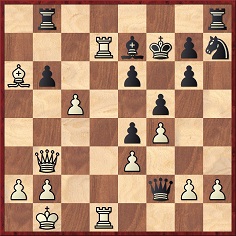
Edward Winter
‘Cukierman ... committed suicide, throwing himself from a balcony for no apparent reason, since he enjoyed excellent health and fortune.’ (A. Alekhine, Informaciones, 3 September 1941)
Guy Las (Jerusalem, Israel) has noted Alekhine’s above-quoted remark and, having a family interest in Cukierman, asks for more information about him.
Jeremy Gaige’s Chess Personalia listed him as Iosif Isaevich Tsukerman, with the spelling Cukierman also mentioned. The Gaige volumes on tournaments show that he finished equal first with S.O. Weinstein in a tournament in Moscow in 1920 (the first Soviet Union National Congress) and won the second City of Moscow Championship (1920-21). At that time he was ‘just a little-known youngster’, according to A. Ilyin-Genevsky (see page 29 of Notes of a Soviet Master). Since Cukierman settled in France in the latter half of the 1920s our subsequent hunting focused mainly on French-language magazines.
They gave his name in various spellings. For instance, in 1929 L’Echiquier used Cuckermann (page 29), Cukerman (page 290) and Cukierman (page 342). It is thus little wonder that some chess databases (for which even the simplest names, places and dates may represent an insuperable challenge) go badly awry with Cukierman. The Essentia and Master Chess (1998) CDs have a game of Capablanca’s in Paris, 1938 against ‘Cukferman’, one of the two that they played there. In giving a number of Cukierman’s games from the Paris, 1933 tournament, ChessBase identifies him as Bernard Zuckerman (who was born a decade later). Such errors by the database debasers are, of course, no rare thing.
Below are two lively specimens of Cukierman’s play from periodicals of the time:
J. Cukierman – André Voisin
Paris (City Championship), 22 November 1928
Queen’s Gambit Declined
1 d4 d5 2 Nf3 c6 3 e3 Bf5 4 c4 e6 5 Qb3 Qc7 6 Nc3 Nf6 7 Bd2 Nbd7 8 Rc1 Qb6 9 c5 Qc7 10 Nh4 Bg6 11 f4 Be7 12 Nxg6 hxg6 13 Be2 Ne4 14 Nxe4 dxe4 15 Qc2 Bh4+ 16 Kd1 f5 17 Qb3 Nf8 18 Kc2 Qd7 19 Kb1 Nh7 20 Rc4 Kf7 21 Rb4 Rab8 22 Ba6 b6 23 cxb6 c5 24 dxc5 Qxd2 25 Rd1 Qf2 26 Rbd4 axb6 27 Rd7+ Be7

28 Qxe6+ Kxe6 29 Bc4+ Kf6 30 R1d6+ Bxd6 31 Rf7 mate.
Source: L’Echiquier, March 1929, pages 104-105.
In his concluding note Znosko-Borovsky wrote:
‘Une partie qui fait grandement honneur à l’art de [M. Cukierman] et surtout à son don de combinaison. Le mat final, précédé de l’idée décisive, devrait avoir place dans toute encyclopédie d’échecs.’
The second game was extensively (and generously) annotated by Tartakower on pages 1075-1077 of the December 1930 issue of L’Echiquier:
J. Cukierman – Savielly Tartakower
Paris (City Championship), 1930
Queen’s Indian Defence
1 d4 Nf6 2 Nf3 b6 3 c4 Bb7 4 g3 c5 5 d5 e6 6 Nc3 exd5 7 cxd5 b5 8 Bg5 b4 9 Ne4 d6 10 Bxf6 gxf6 11 Qa4+ Ke7 12 Nh4 Bc8 13 Bg2 Qb6 14 Rc1 Na6 15 Qb3 Bh6 16 Qf3 f5
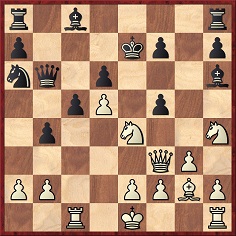
17 Rc4 (Tartakower called this ‘une réponse foudroyante’ and appended two exclamation marks.) 17…fxe4 18 Rxe4+ Kf8 19 Qf6 Bg7 20 Qe7+ Kg8 21 Qe8+ Bf8 22 Re7 Be6 23 dxe6 Rxe8 24 exf7+ Kg7 25 fxe8(Q)+ Resigns.
Throughout most of the 1930s there were three main French-language chess magazines, La Stratégie, L’Echiquier and Les Cahiers de l’Echiquier Français, but by 1941, the year of Cukierman’s demise, they had all ceased publication. Can resourceful readers find anything about him in the French newspapers of the time? [It was subsequently established – see the link below to the Héritage des échecs français webpage – that Cukierman died on 18 November 1940, in Castres.]
The following brief paragraph appeared on page 189 of the July 1941 BCM:
‘News is to hand that Dr O. Bernstein, one of the great figures in chess, who was resident in France for the last 20 years, has been interned in unoccupied France, apparently solely for “racial reasons”. Worse still, Dr Cukierman, one of the leading chessplayers in France, has committed suicide, most likely in order to escape the same fate.’
CHESS (June 1941, page 141) had a little more:
‘The suicide of [Dr J. Cukierman], the Polish master who for many years has been one of the leading players in Paris, is just one of the war’s minor consequences. To lovers of bold and brilliant chess it is a major tragedy. His games are most attractive, and all too seldom published in England.’
The only detailed account we have found of his life is on pages 7-12 of Arcymistrzowie, mistrzowie, amatorzy by Tadeusz Wolsza (Warsaw, 1995), i.e. volume one of his superbly-researched series on Polish chess figures of the past. It is recorded that Józef Cukierman was born in Gródek near Bialystok in 1900. [On 28 March 1899 according to the Héritage des échecs français webpage referred to elsewhere.] Whether he later gallicized his name to Joseph we do not know. He is described as the ‘champion of three capitals’ (i.e. Moscow, Warsaw and Paris), and seven of his best games are given, including one against Ilyin-Genevsky in Moscow in 1920. There is also a list of his tournament results (18 events).
(3106)
The game Alekhine v Cukierman, Paris, 1933 began 1 d4 d5 2 c4 e6 3 Nc3 Nf6 4 Bg5 Be7 5 e3 Nbd7 6 Nf3 O-O 7 Rc1 b6 8 cxd5 exd5 9 Bb5 Bb7 10 O-O a6 11 Ba4 c5 12 Bxd7. In My Best Games of Chess 1924-1937 (page 129) Alekhine gives this note to his 12th move:
‘Much more exact than 12 dxc5 Nxc5 etc., with a playable game for Black, as it happened in a game Capablanca-Teichmann in 1913. If now 12...Qxd7 then 13 dxc5 bxc5 14 Na4! with a decisive position advantage.’
However, Alekhine’s claim to have improved on the Cuban’s play is incorrect. Capablanca-Teichmann had gone 11...Rc8 12 Qe2 c5.
It would be unproductive to note slips in every old book, but it is worthwhile in the case of the great classics.
(617)
The following position (Cukierman v Lazard, Paris, 1929) comes from pages 105-106 of The Quiet Game by J. Montgomerie (London, 1972):
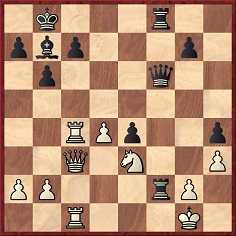
‘In this position Black played 32...Rxg2+ 33 Nxg2 Qf2+ 34 Kh2 e3 35 d5 Qg3+ 36 Kh1 Rf2, and White resigned. All very forceful play by Black and a just result. But there is a flaw. Instead of resigning White should have continued 37 Rg4 and if 37...Qxh3+ 38 Kg1 Qxg4 39 Qxc7+ Ka8 40 Qd8+ Bc8 41 Rxc8+ Kb7 42 Rc7+ Ka6 43 Qc8+, winning comfortably. Instead of 36...Rf2 Black should have played 36...Bxd5, so that if 37 Rg4 Bxg2+, etc.’
The full game is given below, from page 30 of the 1999 Chess Player booklet which included all available games from the tournament:
Josef Cukierman – Frédéric Lazard
Paris, June 1929
Ruy López
1 e4 e5 2 Nf3 Nc6 3 Bb5 f5 4 d4 fxe4 5 Bxc6 dxc6 6 Nxe5 Qh4 7 Be3 Bd6 8 Qd2 Be6 9 Bg5 Qh5 10 Nc3 Nf6 11 Ne2 O-O-O 12 Ng3 Qe8 13 Qa5 Kb8 14 O-O c5 15 c3 Bc8 16 Nc4 b6 17 Nxd6 Rxd6 18 Qa3 cxd4 19 Bf4 Rd8 20 cxd4 Bb7 21 Rac1 Rd7 22 Rc4 Qg6 23 Rfc1 Nd5 24 Be3 h5 25 Qa4 Rf7 26 Qc2 h4 27 Nf1 Rhf8 28 f4 Nxf4 29 Bxf4 Rxf4 30 Ne3 Qf6 31 h3 Rf2 32 Qc3 Rxg2+ 33 Nxg2 Qf2+ 34 Kh2 e3 35 d5 Qg3+ 36 Kh1 Rf2 37 White resigns.
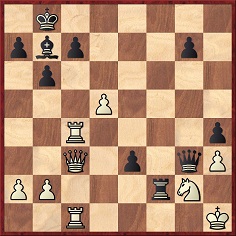
The booklet quoted the game from L’Action française, which also mentioned that White’s resignation was erroneous and asked, ‘Is it luck if you are able to see more than your opponent?’
(3720)
C.N. 3724 remarked that the Belgian magazine L’Echiquier sometimes employed an unusual form of the figurine notation. Below is the full game mentioned in that earlier item. It was given, with notes by Alekhine, on pages 339-341 of the August 1929 issue:

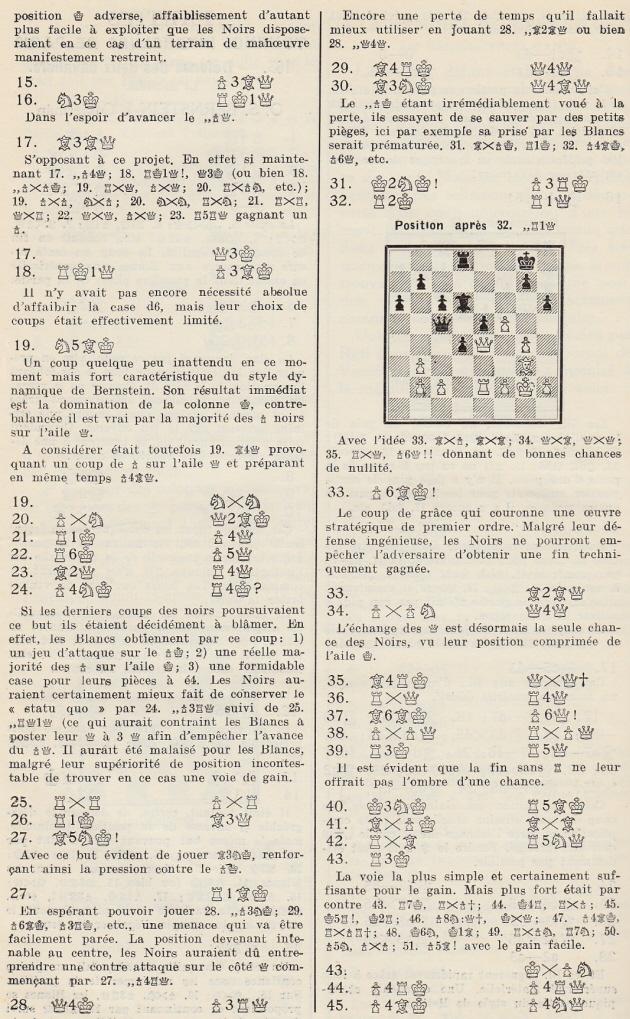

Ossip Samuel Bernstein – Josef Isaevich Cukierman
Two Knights’ Defence
Paris, 24 February 1929
1 e4 e5 2 Nf3 Nc6 3 Bc4 Nf6 4 d4 exd4 5 O-O d6 6 Nxd4 Be7 7 Nc3 O-O 8 Nde2 Be6 9 Bb3 Qd7 10 Nf4 Bxb3 11 axb3 Rfe8 12 Nfd5 Nxd5 13 Nxd5 Bf8 14 Qf3 Ne7 15 Bd2 c6 16 Ne3 Red8 17 Bc3 Qe6 18 Rfd1 f6 19 Nf5 Nxf5 20 exf5 Qf7 21 Re1 d5 22 Re6 d4 23 Bd2 Rd5 24 g4 Re5 25 Rxe5 fxe5 26 Re1 Bd6 27 Bg5 Rf8 28 Qe4 a6 29 Bh4 Qd5 30 Bg3 Qc5 31 Kg2 h6 32 Re2 Rd8 33 f6 Bc7 34 fxg7 Qd5 35 Bh4 Qxe4+ 36 Rxe4 Rd5 37 Bf6 d3 38 cxd3 Rxd3 39 Re3 Rd4 40 Kg3 Rf4 41 Bxe5 Bxe5 42 Rxe5 Rb4 43 Re3 Kxg7 44 h4 a5 45 f4 b5 46 h5 a4 47 bxa4 bxa4 48 Rc3 Rxb2 49 Rxc6 a3 50 Rg6+ Kh7 51 Ra6
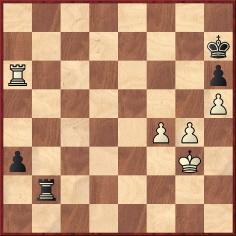
51...Ra2 52 g5 hxg5 53 fxg5 Ra1 54 Ra7+ Kg8
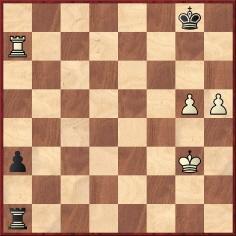
55 g6 a2 56 Kg2 Rb1 57 Rxa2 Rb5 58 Ra8+ Kg7 59 Ra7+ Kg8 60 Rh7 Rg5+ 61 Kh3 Rg1 62 Kh4 Rg2 63 Ra7 Rg1 64 Ra4 Kg7 65 Rg4 Rh1+ 66 Kg5 Rh2 67 Rg1 Rh3 68 Ra1 Rg3+ 69 Kf4 Rg2 70 Ra5 Kh6 71 Rf5 Rg1 72 Ke5 Rg2 73 Rf8 Kg7 74 Rf7+ Kg8 75 Rb7 Re2+ 76 Kf6 Rf2+ 77 Kg5 Rf8 78 h6 Resigns.
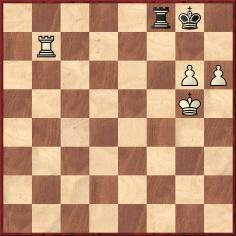
(8766)
Alekhine’s reference at move 51 to Tarrasch and Chigorin concerns their ninth match-game. The remainder of C.N. 8766 gave a relevant extract from Der Schachwettkampf zwischen Dr. S. Tarrasch und M. Tschigorin, Ende 1893 by Albert Heyde (Berlin, 1893), pages 50-51.
One of Gerald Abrahams’ best-known games is his victory over Cukierman in section B of the general congress at Nottingham, 1936. It was included in Alekhine’s tournament book.
See too the Cukierman page on the Héritage des échecs français website.
Latest update: 25 May 2025.
To the Chess Notes main page.
To the Archives for other feature articles.
Copyright: Edward Winter. All rights reserved.